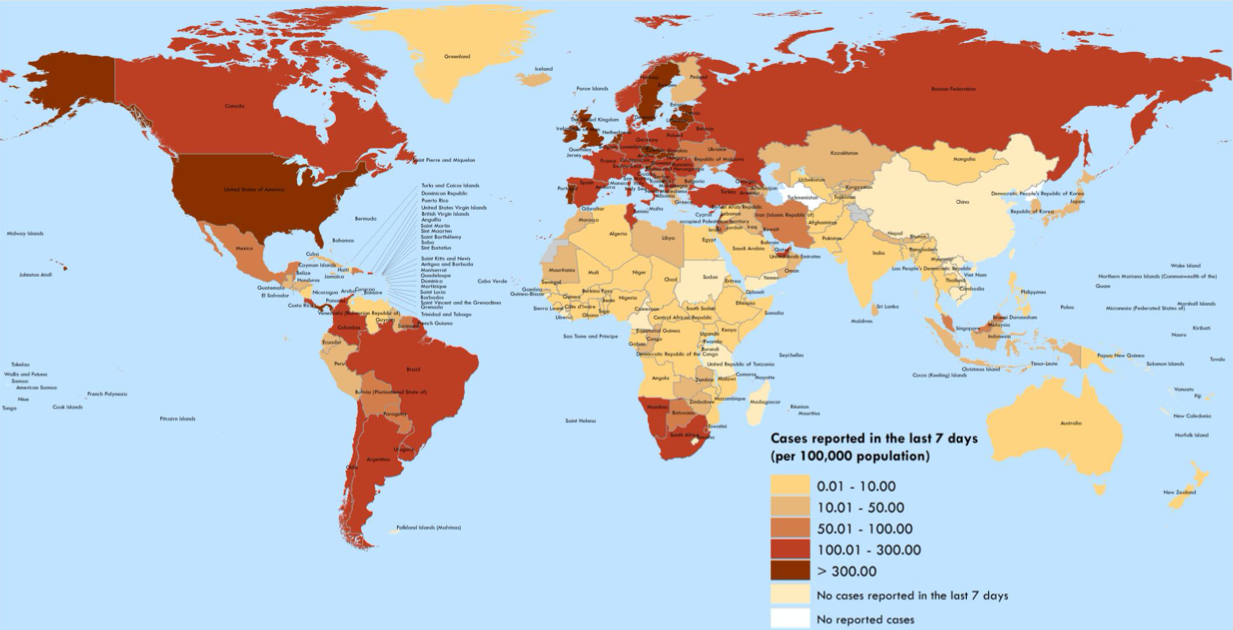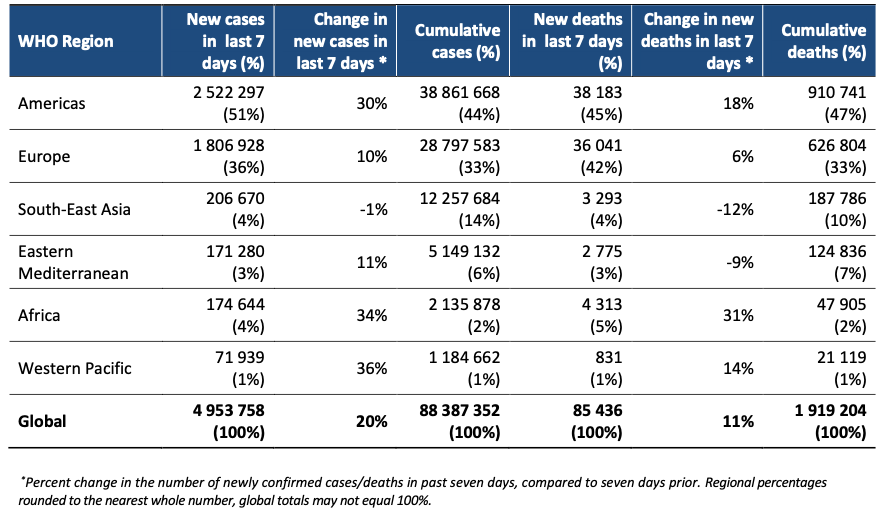
Geneva: With almost 5 million new COVID-19 cases reported globally, even the number of new deaths showed an 11% increase with 85,000 new deaths in the past week ( as of January 10, 2021), as per the World Health Organisation’s COVID-19 Weekly Epidemiological Update.
In the past week, the five countries reporting the highest number of cases were the United States of America (with 1 786 773 cases, a 35% increase), the United Kingdom of Great Britain and Northern Ireland (417 620 cases, a 22% increase), Brazil (313 130 cases, a 24% increase), the Russian Federation (165 167 cases, continuing last week’s decrease with an 12% decrease) and Germany (142 861 cases, reversing last week’s decrease with a 15% increase).

All regions apart from South-East Asia showed an increase in new cases, with the Western Pacific, Africa and the Americas reporting increases of over 30%. The Region of the Americas accounted for 51% of all new cases and 45% of all new deaths globally in the past week. The European Region had a lower increase in new cases (10%), however still accounts for over a third of new cases globally. In South-East Asia, the decline in new cases and new deaths seen since the end of November 2020 continues. Although the Eastern Mediterranean Region is showing an 11% increase in new cases, new deaths have fallen by 9%, continuing a downward trend since a peak in mid-November. The African Region reported 175 000 new cases and 4300 new deaths, an increase of over 30% in new cases and new deaths, far exceeding previous peaks in July 2020. The Western Pacific also reported an increase of more than 30% in new cases, while the number of new deaths also rose by 14%.
In the past week, the African region reported the highest percentage increases in both cases and deaths compared to the previous week. Over 174 000 new cases and over 4300 deaths were reported, that showed steep increases of 34% and 31% respectively. The highest numbers of new cases were reported in South Africa (125 287 new cases; 211.2 new cases per 100 000 population; a 27% increase), Nigeria (8315 new cases; 4.0 new cases per 100 000; a 49% increase) and Zimbabwe (6008 new cases; 40.4 new cases per 100 000; a 293% increase).
The countries reporting the highest number of new deaths in the past week were South Africa (3649 new deaths; 6.2 new deaths per 100 000; a 37% increase), Zimbabwe (106 new deaths; 0.7 new deaths per 100 000; a 194% increase) and Zambia (72 new deaths; 0.4 new deaths per 100 000; a 620% increase).
In the American region over 2.5 million new cases and over 38 000 new deaths were reported this week, a 30% and 18% increase respectively, compared to the previous week. The countries reporting the highest number of new cases in the past week were the United States of America (1 786 773 new cases; 539.8 new cases per 100 000 population; a 35% increase), Brazil (313 130 new cases; 147.3 new cases per 100 000; a 24% increase) and Colombia (100 688 new cases; 197.9 new cases per 100 000; a 26% increase).
The highest number of new deaths this week were reported in the United States of America (20 633 new deaths; 6.2 new deaths per 100 000; a 20% increase), Brazil (6049 new deaths; 2.8 new deaths per 100 000; a 23% increase) and Mexico (5562 new deaths; 4.3 new deaths per 100 000; a 19% increase).
The Eastern Mediterranean Region reported over 171 000 new cases, an increase of 11%. However, the new deaths continued to decrease for the seventh consecutive week with over 2700 new deaths (9% decrease). Iran (42 964 new cases, 51.2 new cases per 100 000 population, a 1% increase), Lebanon (29 145 new cases, 427.0 new cases per 100 000, 72% increase) and United Arab Emirates (16 061 new cases, 162.4 new cases per 100 000, 49 % increase), accounted for almost half (52%) of the new weekly cases in the region. Iran (662 new deaths, 0.8 new death per 100 000 population, 23% decrease), Pakistan (340 new deaths, 0.2 new death per 100 000, 23% decrease) and Egypt (401 new deaths, 0.4 new death per 100 000, a 3 % increase), accounted for almost 60% of deaths reported in the region.
The European region continued to report a substantial number of cases with over 1.8 million new cases and 36 000 new deaths, increases of 10% and 7% compared to the previous week, respectively. The three countries reporting the highest number of new cases remained the same as last week with United Kingdom (417 620 new cases; 615.2 new cases per 100 000, 21% increase), Russian Federation (165 167 new cases, 113.2 new cases per 100 000, 11% decrease) and Germany (142 861 new cases, 170.5 new cases per 100 000, 14% increase). These three countries accounted for almost 40% of all cases reported in the region with the United Kingdom accounting for 23% of all new cases.
The highest numbers of deaths were reported from the United Kingdom (6298 new deaths; 9.3 new deaths per 100 000, 51% increase), Germany (6071 new deaths; 7.2 new deaths per 100 000, 35% increase), and Italy (3409 new deaths; 5.6 new deaths per 100 000, a 1 % increase).
In the South-East Asia region,the three countries reporting the highest number of new cases and new deaths were India (126 319 new cases; 9.2 new cases per 100 000, a 7% decrease; 1564 new deaths; 0.1 new death per 100 000, a 14% decrease), Indonesia (59 913 new cases; 21.9 new cases per 100 000; a 16% increase; 1392 new deaths; 0.5 new death per 100 000, a 11% decrease) and Bangladesh (6198 new cases; 3.8 new cases per 100 000; a 13% decrease; 157 new deaths; 0.1 new death per 100 000; an 8% decrease). India has consistently reported the highest number of new cases and deaths cumulatively in the region since the end of the first week of April 2020.
The Western Pacific region reported an increase in the number of new cases by 36% (over 71 000) and new deaths by 14% (over 800) compared to the previous week. An upward trend in new weekly cases has been reported since late October 2020. The three countries reporting the highest numbers of new cases this week were Japan (39 821 new cases; 31.5 new cases per 100 000, a 68% increase), Malaysia (16 186 new cases; 50.0 new cases per 100 000, a 20% increase) and the Philippines (8881 new cases; 8.1 new cases per 100 000, a 12% increase).
The three countries reporting the highest numbers of new deaths this week were Japan (448 new deaths; 0.4 new deaths per 100 000, a 34% increase), the Republic of Korea (163 new deaths; 0.3 new deaths per 100 000, a 6% increase) and the Philippines (145 new deaths; 0.1 new deaths per 100 000, a 22% decrease).
Newly reported and cumulative COVID-19 confirmed cases and deaths, by WHO Region, as of January 10, 2021
SARS-CoV-2 Variants of concern
a. The geographical extent of two variants – VOC 202012/01 (initially identified in the United Kingdom) and 501Y.V2 (initially identified in South Africa) – reported by countries, territories and areas as of 12 January 2021:
Since first detected on 14 December 2020, VOC 202012/01 has been detected in 50 countries, territories and areas across five of the six WHO regions to date (Figure 3). In England, the variant has been detected in all regions and almost all local authorities. Here, investigations are using a proxy S gene target failure (SGTF) to indicate carriage of the VOC, as only a small proportion of these variants is detected using whole genome sequencing, which lags approximately two weeks behind the initial test date. Results show that the age and sex distribution of VOC 202012/01, as determined by SGTF, is similar that of other variants in circulation over the same period. Analyses using contact tracing data showed higher transmissibility (secondary attack rates) where the index case has the variant strain, from around 11% to 15% of named contacts.
Also read: Likelihood of emergence of more variants of the COVID-19 virus is not ruled out
Since first reported on 18 December 2020, variant 501Y.V2 has been detected in 20 countries, territories and areas across four of the six WHO regions (Figure 4). From preliminary and ongoing investigations in South Africa, it is possible that the 501Y.V2 variant is more transmissible than variants circulating in South Africa previously. Moreover, while this new variant does not appear to cause more severe illness, the observed rapid increases in case numbers has placed health systems under pressure.
b. Recent reports of other new variants of potential concern:
On 9 January, Japan notified WHO of a new SARS-CoV-2 variant within lineage B.1.1.28 (initially reported as B.1.1.248) detected in four travelers arriving from Brazil. This variant has 12 mutations to the spike protein, including three mutations of concern in common with VOC 202012/01 and 501Y.V2, i.e.: K417N/T, E484K and N501Y, which may impact transmissibility and host immune response.
Researchers in Brazil have additionally reported the emergence of a similar variant also with a E484K mutation, which has likely evolved independently of the variant detected among Japanese travellers. The extent and public health significance of these new variants require further investigation.
– global bihari bureau





